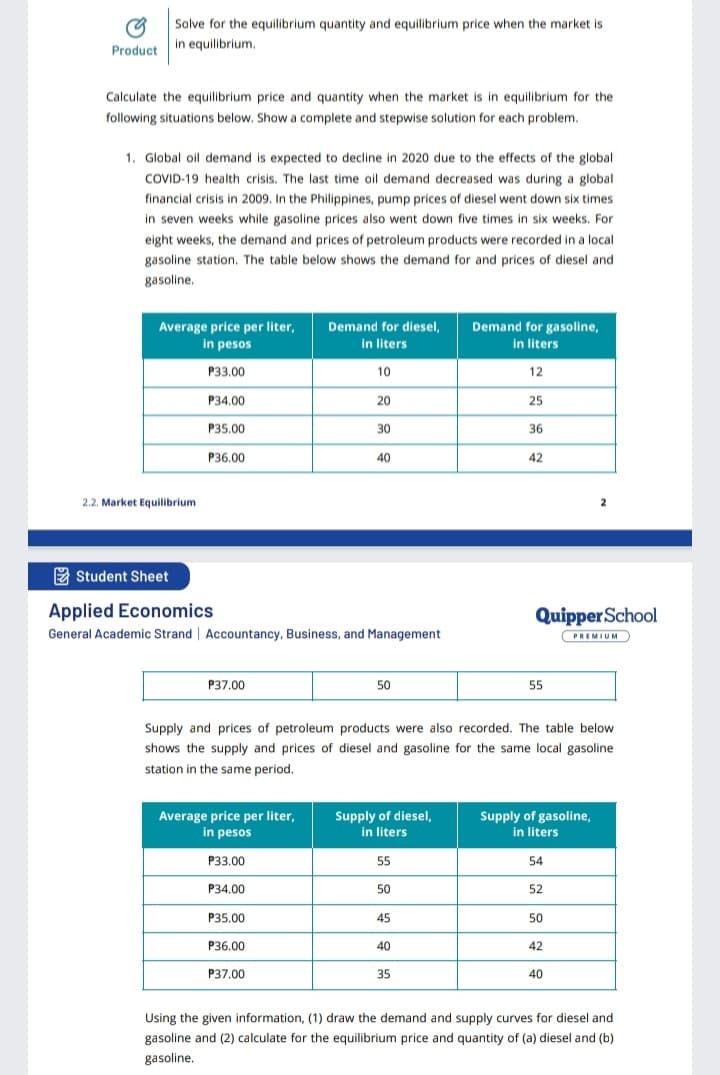Calculate the equilibrium price and quantity when the market is in equilibrium for the following situations below. Show a complete and stepwise solution for each problem. 1. Global oil demand is expected to decline in 2020 due to the effects of the global COVID-19 health crisis. The last time oil demand decreased was during a global financial crisis in 2009. In the Philippines, pump prices of diesel went down six times in seven weeks while gasoline prices also went down five times in six weeks. For eight weeks, the demand and prices of petroleum products were recorded in a local gasoline station. The table below shows the demand for and prices of diesel and gasoline. Average price per liter, in pesos Demand for gasoline, in liters Demand for diesel, in liters P33.00 10 12 P34.00 20 25 P35.00 30 36 P36.00 40 42 2. Market Equilibrium tudent Sheet ied Economics Quipper School IAcademic Strand | Accountancy, Business, and Management PREMIUM P37.00 50 55 Supply and prices of petroleum products were also recorded. The table below shows the supply and prices of diesel and gasoline for the same local gasoline station in the same period. Average price per liter, in pesos Supply of diesel, in liters Supply of gasoline, in liters P33.00 55 54 P34.00 50 52 P35.00 45 50 P36.00 40 42 P37.00 35 40 Using the given information, (1) draw the demand and supply curves for diesel and gasoline and (2) calculate for the equilibrium price and quantity of (a) diesel and (b) gasoline.
Calculate the equilibrium price and quantity when the market is in equilibrium for the following situations below. Show a complete and stepwise solution for each problem. 1. Global oil demand is expected to decline in 2020 due to the effects of the global COVID-19 health crisis. The last time oil demand decreased was during a global financial crisis in 2009. In the Philippines, pump prices of diesel went down six times in seven weeks while gasoline prices also went down five times in six weeks. For eight weeks, the demand and prices of petroleum products were recorded in a local gasoline station. The table below shows the demand for and prices of diesel and gasoline. Average price per liter, in pesos Demand for gasoline, in liters Demand for diesel, in liters P33.00 10 12 P34.00 20 25 P35.00 30 36 P36.00 40 42 2. Market Equilibrium tudent Sheet ied Economics Quipper School IAcademic Strand | Accountancy, Business, and Management PREMIUM P37.00 50 55 Supply and prices of petroleum products were also recorded. The table below shows the supply and prices of diesel and gasoline for the same local gasoline station in the same period. Average price per liter, in pesos Supply of diesel, in liters Supply of gasoline, in liters P33.00 55 54 P34.00 50 52 P35.00 45 50 P36.00 40 42 P37.00 35 40 Using the given information, (1) draw the demand and supply curves for diesel and gasoline and (2) calculate for the equilibrium price and quantity of (a) diesel and (b) gasoline.
Principles of Economics, 7th Edition (MindTap Course List)
7th Edition
ISBN:9781285165875
Author:N. Gregory Mankiw
Publisher:N. Gregory Mankiw
Chapter4: The Market Forces Of Supply And Demand
Section: Chapter Questions
Problem 11PA
Related questions
Question

Transcribed Image Text:Solve for the equilibrium quantity and equilibrium price when the market is
in equilibrium.
Product
Calculate the equilibrium price and quantity when the market is in equilibrium for the
following situations below. Show a complete and stepwise solution for each problem.
1. Global oil demand is expected to decline in 2020 due to the effects of the global
COVID-19 health crisis. The last time oil demand decreased was during a global
financial crisis in 2009. In the Philippines, pump prices of diesel went down six times
in seven weeks while gasoline prices also went down five times in six weeks. For
eight weeks, the demand and prices of petroleum products were recorded in a local
gasoline station. The table below shows the demand for and prices of diesel and
gasoline.
Demand for gasoline,
in liters
Average price per liter,
Demand for diesel,
in pesos
in liters
P33.00
10
12
P34.00
20
25
P35.00
30
36
P36.00
40
42
2.2. Market Equilibrium
2 Student Sheet
Applied Economics
Quipper School
General Academic Strand Accountancy, Business, and Management
PREMIUM
P37.00
50
55
Supply and prices of petroleum products were also recorded. The table below
shows the supply and prices of diesel and gasoline for the same local gasoline
station in the same period.
Supply of diesel,
in liters
Supply of gasoline,
in liters
Average price per liter,
in pesos
P33.00
55
54
P34.00
50
52
P35.00
45
50
P36.00
40
42
P37.00
35
40
Using the given information, (1) draw the demand and supply curves for diesel and
gasoline and (2) calculate for the equilibrium price and quantity of (a) diesel and (b)
gasoline.
Expert Solution
This question has been solved!
Explore an expertly crafted, step-by-step solution for a thorough understanding of key concepts.
This is a popular solution!
Trending now
This is a popular solution!
Step by step
Solved in 2 steps with 2 images

Recommended textbooks for you

Principles of Economics, 7th Edition (MindTap Cou…
Economics
ISBN:
9781285165875
Author:
N. Gregory Mankiw
Publisher:
Cengage Learning

Essentials of Economics (MindTap Course List)
Economics
ISBN:
9781337091992
Author:
N. Gregory Mankiw
Publisher:
Cengage Learning

Principles of Microeconomics (MindTap Course List)
Economics
ISBN:
9781305971493
Author:
N. Gregory Mankiw
Publisher:
Cengage Learning

Principles of Economics, 7th Edition (MindTap Cou…
Economics
ISBN:
9781285165875
Author:
N. Gregory Mankiw
Publisher:
Cengage Learning

Essentials of Economics (MindTap Course List)
Economics
ISBN:
9781337091992
Author:
N. Gregory Mankiw
Publisher:
Cengage Learning

Principles of Microeconomics (MindTap Course List)
Economics
ISBN:
9781305971493
Author:
N. Gregory Mankiw
Publisher:
Cengage Learning

Principles of Economics (MindTap Course List)
Economics
ISBN:
9781305585126
Author:
N. Gregory Mankiw
Publisher:
Cengage Learning


Principles of Macroeconomics (MindTap Course List)
Economics
ISBN:
9781285165912
Author:
N. Gregory Mankiw
Publisher:
Cengage Learning